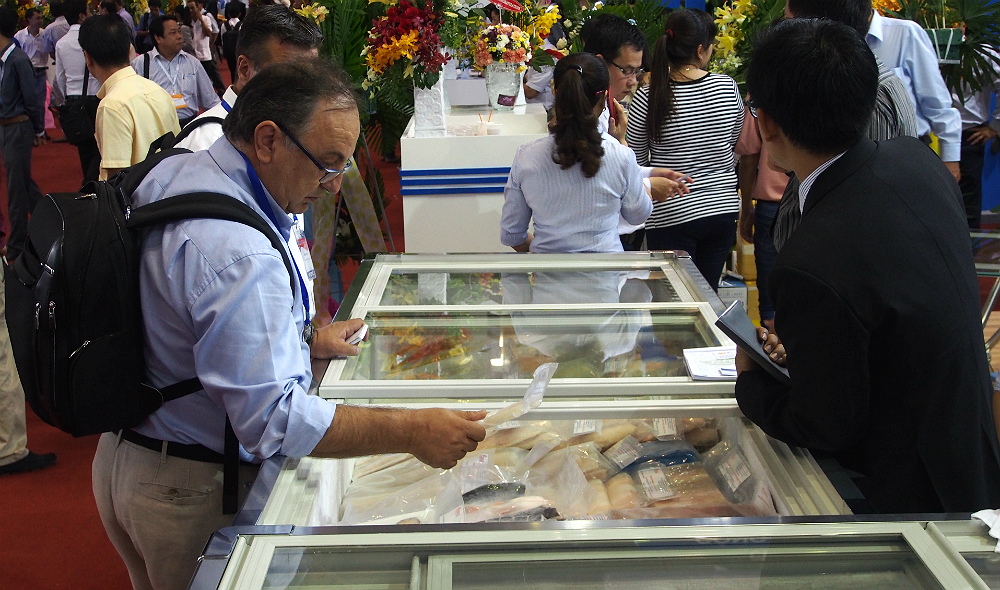Vietnam’s seafood shipments in the first three months of this year saw the biggest fall in five years, which squeezed the earnings of local farmers as a result.
The Vietnam Association of Seafood Exporters and Processors (VASEP) has estimated that the country’s total seafood export turnover in the first quarter reached US$1.27 billion, down 23 percent compared to the same period in 2014.
That is the biggest drop in the past five years, VASEP said.
The value of two major Vietnamese export items shrimp and pangasius fell sharply in the first three months, with $348.6 million (down 30 percent year on year) and nearly $225 million (down 18 percent year on year), respectively.
According to VASEP, the local currency in many export markets, especially in Europe, has sharply lost its value against the dollar recently.
As over 90 percent of Vietnamese seafood enterprises choose the U.S. dollar as the currency for payments for their foreign partners, the appreciation of the greenback against other currencies in Vietnam’s export markets, such as the EU, Japan, and Australia, has negatively affected the competitiveness of local enterprises and their goods.
This has forced Vietnamese seafood exporters to lower their prices so as not to lose their customers there.
"Vietnamese enterprises have no choice but to lower their prices so that they can sell their goods easily, or stockpile their shipments in warehouses, waiting for prices to rise,” Duong Ngoc Minh, general director of Hung Vuong Co., told Tuoi Tre (Youth) newspaper.
“But fluctuations in exchange rates will last for many months ahead, and the problem may not be resolved in the next few months,” Minh said.
Hung Vuong is a big seafood processor and exporter based in the Mekong Delta province of Tien Giang.
The recent euro depreciation against the dollar has put importers in Europe at a disadvantage. Therefore, many customers there have chosen to pay for prices 10-15 percent lower than before to maintain their competitiveness, said the general director of the firm specializing in pangasius products.
Tran Van Linh, general director of Thuan Phuoc Seafood Co. in the central city of Da Nang, said last year the price of shrimp exports to the U.S. was high, which thus produced a spillover effect on the prices in other markets.
But the picture has changed dramatically since the beginning of 2015, with abundant supplies from other exporting countries such as India, Indonesia, and Thailand, Linh said.
As the goods exported from those countries have been supported by weakened currencies, which are all floated, their prices are now more competitive than those of Vietnamese seafood products, he said.
Along with the high anti-dumping duty rates the U.S. Department of Commerce slapped on Vietnamese shrimp, local exporters have to cut prices further if they want to sell their goods in the U.S. market, he added.
"But if the prices are cut so sharply, Vietnamese exporters will suffer losses and many have chosen to raise their inventories so as not to sell at low prices,” Linh said.
The moves of foreign importers and local exporters, consequently, have caused shrimp and fish prices to plummet, according to VASEP.
Adverse impacts
Local aqua-farmers are in trouble as the price of their produce has gone down so dramatically due to declining seafood exports.
From an annual volume of over 2,000 metric tons of pangasius four years ago, farmer Nguyen Hoang Trung in Cao Lanh District in the Mekong Delta province of Dong Thap has cut it by ten times to around 200 metric tons of the fish at the present time.
"While the price of the fish is uncertain, local companies will only buy our products when the price is low, which will severely affect our earnings,” he said.
With a price of VND24,000-24,500 per kilogram at the start of this year, a farmer, like Trung, enjoyed a profit margin of VND1,000-1,500 per kilogram.
But with the current price of VND23,000, it is a break-even. And if that price drops further, farmers will incur losses.
"Local plants have said as export prices fell, they cut the purchase price for my fish,” Trung said.
Trung is not alone because many catfish farmers in the Mekong Delta are in the same situation. Shrimp farmers are also in the same boat.
According to Tran Van Ngan in Dam Doi District in the southernmost province of Ca Mau, the shrimp price has fallen around VND19,000 per kilogram, or roughly 20 percent, compared to that of earlier this year, to about VND81,000 per kilogram.
But in comparison with the price in the middle of last year, the current quote is a 40 percent drop, Nam said.
With this price, competent farmers may get a break-even, but poorer ones will suffer, he added.
Like us on Facebook or follow us on Twitter to get the latest news about Vietnam!




















































